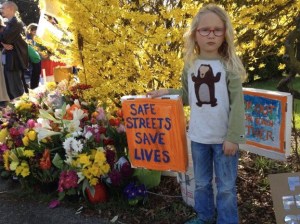All Eyes on Portland at Bike Summit

An organized ride on one of Portland’s bike boulevards.
If there was a star at yesterday’s National Bike Summit, it was Portland, Oregon. After Earl Blumenauer, one of the city’s congressional reps and a former county commissioner, delivered the morning address, Portland’s bike planners and advocates shared their strategies at some of the more urban-focused panels. Portland’s transportation commissioner, Sam Adams — who is now running for mayor — was scheduled to deliver a post-lunch plenary, but he canceled with the flu. Instead, a contingent of five other Portland bike luminaries shared the podium.
Two things stood out about the city that has achieved a cycling mode share of six percent and is aiming much higher:
They’re big believers in bike boulevards.
Streetsblog and StreetFilms have covered Portland’s bike boulevards before, but I wanted to share some of the reasoning behind them. Portland has essentially set the goal of becoming the Amsterdam of the U.S. (as far as bikes are concerned), and they don’t think that’s possible if they rely mainly on bike lanes on heavily trafficked roads. According to their surveys, only one percent of people making trips (all modes) on Portland streets fall under the category of “fearless” cyclists. The bigger chunk of bike mode share comes from people who have safety concerns, and another huge portion of travelers — 55 percent — say they would cycle if conditions were even safer than today.
Their surveys also tell them that what makes people feel safe is biking on low-traffic streets, leading them to convert more streets into bike boulevards. By building facilities where bikes outnumber cars and riders seldom have to stop, Portland’s bike planners believe they can make cycling a desirable mode for trips like, say, taking your kids to the library.
They do intensive education and outreach.
The Portland Office of Transportation runs an outreach program called SmartTrips, which Streetsblog first covered last September. Here’s a little more about how SmartTrips operates.
Every year the program selects an area of the city to target for outreach. Beginning in April, they send out information about walking, biking, and transit to everyone in the area, contacting each household at least five times. The first thing they send is an order form, which people fill out to request things like bike maps, a schedule of rides, and leg bands. When the SmartTrips office receives an order, interns deliver the goods by bike within three days.
"People are shocked
that interns get there by bike, and that the city is actually doing it," said SmartTrips’ Dan Bower. "Every year we get a 8-10 percent reduction in drive alone trips in the target region." Noting that ridership is skyrocketing in Portland despite the fact that the city hasn’t built many new bikeway miles in the past five years, he summed up his program’s raison d’etre: "If you build something, it’s worth your
while to tell people about it."
Also worth noting — this list of “five things you don’t know about Portland,” presented by the crew who spoke at the lunchtime plenary:
- The growing social acceptance of biking
Even residents who don’t bike say they like living in a city that is so bike-friendly.
Store owners are calling the city and asking to have on-street parking removed and replaced by bike parking. - Financing – they haven’t spent big bucks, yet
Only one percent of Portland’s transportation budget is spent on bike facilities. Ridership is way up nonetheless. Now that cycling is at six percent mode share, there is talk of allocating funds based on mode split. - Biking boosts tourism
According to Travel Portland, being named the nation’s top cycling city has been very valuable for tourism. Portland is now attracting conventions based on its bike infrastructure. The North American Handmade Bicycle Show, a convention that draws 15,000 participants, is a case in point. - Low-cost publicity and lobbying
Every year, Cycle Oregon stages a policy-makers’ ride, inviting influential people to get away from their desks and see what’s working for bikes in the city and what’s not. - The economic development crowd is getting behind biking
There are now 10-15 bike manufacturers in Portland and new bike shops popping up all the time. It’s a stretch to call this a “thing you don’t know.” Portland’s bike industry has actually gotten national press.
Photo: BikePortland.org / Flickr
